Contents:
1) Stamou Lelouda: The effect of Suzuki instruction and early childhood music experiences on developmental music aptitude and performance achievement of beginning Suzuki string students
2) Papapanagiotou Xanthoula: Adolescence, Music and Education
3) Economidou-Stavrou Natassa: Music Curriculum in First-grade Education in Cyprus - From Intention to Reality
4) Bessas Dimitris, Kokkidou May: The Music Teacher through the Curricula (1969-2004)
5) Likesas Georgios, Konstantinidou Maria, Papadopoulou Sophia: Creative lesson of traditional dance teaching at the first classes of Elementary School
Abstracts:
1) Lelouda Stamou
The effect of Suzuki instruction and early childhood music experiences on developmental music aptitude and performance achievement
of beginning Suzuki string students
The study aimed at investigating a) the effect of Suzuki instruction on developmental music aptitude of beginning Suzuki string students, b) the extend to which students developmental music aptitudes at the beginning of instruction were predictive of their instrumental performance achievement after 22 weeks of Suzuki instruction, and c) the effect of early childhood music instruction on Suzuki string students future instrumental performance achievement. The sample consisted of 43 beginning Suzuki string students (experimental group) and 73 general music students (control group) between the ages of 5 and 8 years old. All subjects were pre- and post-tested using Primary Measures of Music Audiation (PMMA). Instruction lasted for 22 weeks and consisted of Suzuki string instruction for the experimental group and general music instruction for the control group. At the end of the 22-week period, 26 Suzuki students were audiotaped and were rated by three independent judges on Intonation, Rhythm, and Expression. Results indicated that Suzuki students tended to have higher post-instruction PMMA Tonal and Composite mean scores and lower Rhythm mean scores than the general music students. None of those differences was, however, found to be statistically significant. Suzuki students' pre-instruction PMMA scores were predictive of their string performance achievement after 22 weeks of instruction. Finally, Suzuki students who had received early childhood music instruction tended to receive higher, although non-significantly so, instrumental performance achievement ratings than students who did not have such instruction. Due to non-significant results, further research is needed if the effects of Suzuki instruction on musical development are to be defined and the importance of early childhood music instruction for future musical success is to be determined.
2) Xanthoula Papapanagiotou
Adolescence, Music and Education
This paper deals with the importance of music to adolescents in everyday life situations, both at home and in school. Relevant studies are reviewed and the approach that is followed is, mainly, a social-psychological one. Suggestions for research in the field of secondary music education in Greece are made and speculations concerning the teaching of music in secondary education are articulated.
3) Natassa Economidou-Stavrou
Music Curriculum in First-grade Education in Cyprus - From Intention to Reality
Intention and reality are two views of the curriculum that often differ widely. The main aim of this study was to investigate whether there was a mismatch between the official National Curriculum for Music and the one received by children in Primary Education in Cyprus. The reality of childrens experience was investigated by an anonymous questionnaire administered by the researcher to 1196 out of the 9847 Cypriot 6thgrade children. The questionnaire aimed to identify the level of musical Knowledge acquired by the children during their music lessons in primary school, their attitudes towards classroom music as well as their preferences on musical activities. The results showed that there is a huge gap between theory and practice as far as music teaching in Cypriot Primary Education is concerned. Music was very surprisingly found to be one of the childrens least favourite subjects taught in primary school, the activities that according to children often took place in their music lessons differed extremely with the ones they would like to participate in, and finally, the musical knowledge acquired was far below the expected level.
4) Dimitris Bessas, May Kokkidou
The Music Teacher through the Curricula (1969-2004)
In the course of music, the schoolteacher is called to help and to inspire the students to develop their creativity, their imagination and their self-monitoring and to find various ways of expression. Furthermore, he has to introduce to students the basic musical concepts and to initiate them into the world of music so they become critical listeners and feel aesthetic pleasure at the hearing of music. The sections where the training process is mainly focused are the song, the hearing of music, the music theory, the music instruments and the music activities with movement and dance. What kind of supplies does the schoolteacher need in order to be effective in the class? Is he prepared for this role? What are precisely the requirements raised by Curricula? Is it possible the same Curriculum to be addressed in schoolteachers of general education and in special music teachers? The present work attempts to give answers to the above questions, through an archival research, an exhaustive examination of Curricula on the course of music, from 1969 until today.
5) Likesas Georgios, Konstantinidou Maria, Papadopoulou Sophia
Creative lesson of traditional dance teaching at the first classes of Elementary School
The purpose of the present study is to refer the basic elements necessary for the construction of educational programs aiming to a more qualitative teaching of Greek traditional dances in elementary education. At the age of obligatory education, it is important for the children to learn all about their body and the world around them with no pressure and compulsion. The pressure and the criticism prevent childrens creativity, whilst encouragement and free expression are basic presumptions for the development of their self-confidence, autonomy and independence. In such way children gain more initiative of creating their original movement activities into the class and enhance their creativeness. The creative way of teaching traditional dances presupposes the construction of a pleasant educational program, which will lead the student and prepare him to face the new developments with respect to the tradition and the cultural heritage. This program should contain the understanding and learning of basics meanings related to body, time, space, rhythm, flow and dynamic of movement. Through this way of learning traditional dances it is enhanced the free personal expression of children and it is attained a holistic development of children's personality while it is establishing their lifetime involvement in physical and dance activities.
1) Androutsos Polyvios: Research and Educational Practice: Dialogue or gap?
2) Kitsiou Chrisa: "Examination of Music Acoustic Ability". Analysis and axiological approach of similar systematic procedure
3) Koniari Dimitra: Absolute Pitch: A brief review of the literature.
4) Vamvoukli Mariza: Dyslexic children & teaching of music: Recognizing and overcoming the difficulties.
5) Papanikolaou Evi: Guided Imagery and Music (GIM) as a form of therapy for children and adolescents.
Abstracts
1) Polyvios Androutsos
Research and Educational Practice: Dialogue or gap?
This paper explores the relationship between music education research and educational practice. As it is evident in the relevant literature there is a gap between research and educational practice. The speculation in which the international music education community is engaged is presented and the causes of the problem are examined. Following this, successful examples of efforts to bridge the gap are presented, and ways to achieve a fruitful and efficient dialogue are explored. Towards this direction proposals are given that are based in successful practices of collaboration between researchers and teachers. Finally some suggestions are given to avoid this problem in the Greek music education reality.
2) Chrisa Kitsiou
"Examination of Music Acoustic Ability". Analysis and axiological approach of similar systematic procedure
This study aimed at investigating the new way to examine Dictee at Panhellenic Exams. Specifically, it deals with the structure, content and application of the test. For this reason, two tests were created, similar to the ones of the Panhellenic Exams of 2003 and 2004. A total of 178 senior and alumnus students took these tests. The two created tests are representative of the original ones. There were also questionaries created that were filled by first year students of Greek Music Universities who were examined with the new way "Examination of Music Acoustic Ability". From the theoretical approach of the test, the conclusions from the descriptive and statistic analysis, of the data of tests, the remarks of the questionaries and the problems that took place at the time of Panhellenic Exams, it seems that there are many things to be reconsidered so that the reliability of the test will increase on following exams of next years.
3) Dimitra Koniari
Absolute Pitch: A brief review of the literature
Absolute pitch (AP) is the ability to identify a tone's pitch or to produce a tone at a particular pitch without the use of an external reference pitch. AP exists in varying degrees among musicians generally described as AP possessors. Although the aetiology of AP is not yet completely understood, evidence points toward the early-learning theory. This theory states that AP can be learned by anyone during a limited period early in development, up to about age 9, after which a general developmental shift from perceiving individual features to perceiving relations among features makes AP difficult or impossible to acquire. The paper discusses the above findings and highlights the importance of the role of the specialised music educator in early childhood music classrooms.
4) Mariza Vamvoukli
Dyslexic children & teaching of music: Recognising and Overcoming the Difficulties
This article focuses on the teaching of music to dyslexic children, the nature of their difficulties and the strong need for special care to be taken. This consists in a redefinion of the priorities in music education, reconsideration of the role of musical notation (in the sense that its high importance is not an undoubted fact) and recognition of the need for a special approach: multi-sensory, systematic, proceeding step by step and giving precedence to doing and experience first and theory and symbols afterwards. Specific suggestions are made for aspects/fields of music that can be practiced and improved, such as the sense of rhythm, of pitch, of harmony and tonic centres and the understanding of the structure of musical pieces. Kodaly method is briefly mentioned as a particularly suitable one and, lastly, it is stressed that dyslexic pupils need extra encouragement compared with the rest of the pupils, as their self-esteem is normally a low one due to the difficulties they face in everyday life. Music is suggested as an involvement, if not always able to be the decisive solution but certainly as a steady source of enjoyment and creation.
5) Evi Papanikolaou
Guided Imagery and Music (GIM) as a form of therapy for children and adolescents
Guided Imagery and Music (GIM) is a form of music-assisted psychotherapy that has been used in various settings, with diverse populations and for a variety of therapeutic, educational and developmental purposes. Central to this method are a preliminary conversation, a relaxation and induction, a music-imaging experience, a return to an alert state, and a closing conversation on the symbolic meaning or processing of the images created during the music listening part of the session. In the individual form, the "traveller" maintains an ongoing dialogue with the guide while imaging to the music, whereas in the traditional group form, the travellers engage in dialogue, after the music-listening session. While GIM is used mainly with adults, it may also be used quite effectively with children and adolescents, although goals and method may differ. The purpose of this paper is to demonstrate how GIM has been used with this particular population, starting with the original model and then examining further adapted modifications of it. This will be accomplished by reviewing a collection of studies using GIM with children and adolescents, in various settings such as schools, special education units, and medical and psychiatric in-patient units. All of the studies describe practical applications of GIM with this population although few of them have attempted research applications for GIM with children and adolescents. The purpose of this paper is also to discuss some implications for future development of the GIM psychotherapy method, aimed at achieving a higher effectiveness while working within this particular client group.
1) Xanthoula Papapanagiotou: Greek students' musical preferences in relation to age and musical training.
2) Yannis Stavrou:The educational policy related to the teaching of music
in Primary School.
3) Polyvios Androutsos: Development and Experimental Implementation of a Model of Teaching the History of Music in Secondary Education.
4) Kyriaki Zacharopoulou: An introduction to mechanisms and strategies
used by performers to memorise music.
5) Maria Vraka: Absolute Pitch - The advantages and the drawbacks of a rare ability.
Abstracts
1) Xanthoula Papapanagiotou
Greek students' musical preferences in relation to age and musical training
This paper reports on two studies that were carried out in Greece and aimed at investigating Greek students musical preferences and their relationship to age and musical training. In the first study, 1061 students aged 6-7, 12-13 and 18-19 years gave questionnaire information and participated in a listening test during which they rated excerpts of 8 musical styles on a five-point Likert-type scale. The second study aimed at further investigating the relationship between musical preferences and training. Participants were 120 students equally distributed in three groups: 11 year old primary, 15 old year secondary and 15 year old music school. Students rated the stylistic «labels» of «pop», «classical» and «Greek traditional» music on a five-point Likert-type scale. Statistical analyses in both studies indicated a strong relationship between preferences, age and musical training. It was found that children respond more favourably to all styles of music than older students. Adolescents show strong preferences towards musical styles associated with young audiences. Young adults' musical preferences are more diverse compared to adolescents' and less diverse as compared to childrens' musical preferences. Musical training on an instrument of either «classical» or «Greek traditional» tradition was found to positively influence musical preferences for both traditions. The paper concludes that school music education in Greece should be enriched with musical praxis in diverse musical traditions.
2) Yannis Stavrou
The educational policy related to the teaching of music in Primary School
The educational policy applied in every society determines the educational goals and orientation, the subject matter and the content of books, the targets of the syllabus as well as every other parameter concerning the educational sections. Therefore, the place of music, traditional music in particular, in school reflects the attitude of the state, the priorities that it puts the model of personality of the citizens that it aims at formulating, its directions, its choices and its priorities. But it's a fact that the place of music in school has been determined by factors such as the inadequacy of the educationalists as well as the wrong perception that prevailed, according to which music is not connected with knowledge and consequently it should not be regarded as an essential school subject. In this article are presented the results of a research that aimed at investigating the attitudes and the opinions of educationalists who teach the subject of Music Education in Primary School (teachers specialized in the teaching of music as well as teachers in general), in terms of the educational policy related to the teaching of music as a whole, and traditional music in particular. The analysis of the data reveals that educationalists believe that the State does not promote the teaching of music with the means available to it. They are also dissatisfied with certain factors such as the syllabus, the visual aids, the classroom, the School Counselors, the seminars and further training sessions they have attended. Finally, they consider that in order for the targets aiming at the teaching of music to be fulfilled (including traditional music) it is necessary to make alterations in every factor that affects the potentiality of the subject.
3) Polyvios Androutsos
Development and Experimental Implementation of a Model of Teaching the History of Music in Secondary Education
The purpose of the study was to develop and implement a model of teaching the history of music in secondary education. The researcher investigated whether and to what degree this model facilitated student achievement in the history of music, including the development of skills of historic perception, comprehension of historic continuity, and listening recognition and placement of musical works in their historic framework. The model consisted of the following components: strategy, methods, tools, and teaching material. Subjects were ninthgrade public general secondary education students in Greece (N=176). An experimental-control group post-test only design was used. Eight intact classes were randomly assigned to experimental and control groups taking under consideration regional representation (i.e., urban and rural areas). The instruction period for both groups was 10 weeks, during which the Baroque and Classical eras of Western art music were covered. The experimental group was taught accordingly to the model whereas the control group according to the choices of the control group teachers. During the 11th week, a review and format trial test took place. During the 12th week, a multiplechoice format test, designed by the investigator, was administered. The results showed the test to be reliable. The data were analyzed through three-way ANOVA procedures. The statistically significant difference between the control and experimental groups in favor of the experimental group and the statistical significance of two interactions (treatment x gender and region x gender) demonstrated the success of the model and its components. The results in general showed that the model and its components had a substantial positive effect on male students' achievement. The model proved to be useful and viable and the teaching materials appropriate for actual use in the schools.
4) Kyriaki Zacharopoulou
An introduction to mechanisms and strategies used by performers to memorise music
Memory is a very significant cognitive process, which is used by musicians while studying and memorising a musical piece. The goal of the current article is to inform performers on the way their memory system works and in parallel, to suggest effective strategies of memorisation. In the first part of this article, a short description of the main psychological theories on memory processes will be made. In the second part, an account of the most common strategies in memorising music will be given, and the most effective will be proposed.
5) Maria Vraka
Absolute Pitch: The advantages and the drawbacks of a rare ability
Absolute Pitch is a relatively rare ability. An increased interest has been expressed on the matter by a number of investigators coming from scientific areas as different as psychoacoustics, neuroscience, developmental Psychology and Music Education. The immediate and accurate recognition of musical pitch seems to be affected by specific characteristics of musical sound such as musical 'chroma', timbre, pitch register. The ability is associated with the musical system of the Western Art European Music due to the dual nature of the trait: tonal memory and tonal labeling. Nevertheless, it is Relative Pitch rather than Absolute Pitch that is important in the previously mentioned musical tradition. The article tries to record the advantages and disadvantages of possessing AP, in a musical system that seems to ignore or rather not be in need of the ability. Some musical abilities can be underdeveloped in people with AP. The importance of a special educational approach is highlighted and some suggestions made.
This G.S.M.E. 10th anniversary special issue of the Musical Pedagogics Journal originated with a symposium on the topic of David Elliott's Praxial Philosophy of Music Education. The symposium titled Praxial Music Education: Issues and Debates was held in July 21st, 2006 at the 27th World Conference of the International Society of Music Education (ISME) in Kuala Lumpur, Malaysia. This issue of Musical Pedagogics features the full contents of the 2006 ISME Praxial Symposium, translated in Greek (English abstracts).
1) David J. Elliott:The Praxial Philosophy of Music Education: A Summary
2) Polyvios Androutsos: Praxial Philosophy and Educational Praxis
3) Jiaxing Xie: The Praxial Music Education of China - in the Traditional and Post-modern Contexts
4) Heidi Westerlund & Lauri Vakeva: Elliott's Praxialism in Music Education: A Finnish Perspective
5) Jere Humphreys:Plato's views on three modes of music education Praxis: composing, performing and listening
Abstracts:
1) David Elliott
The Praxial Philosophy of Music Education: A Summary
This summary of the praxial philosophy -in attempt to be useful and clear- is organized in relation to seven basic "issues" that are almost always present in music teaching-learning situations: aims, knowledge, teachers, learners, teaching-learning processes, the teaching-learning context, and evaluation.
2) Polyvios Androutsos
Praxial Philosophy and Educational Praxis
Although a single, unitary philosophy for a field as complex as music education is probably not realistic, David Elliott's praxial philosophy represents a significant step forward. Based on the praxial views of Aristotle and others who followed him, Elliott's praxial philosophy has brought into focus the importance of "music making in general and musical performing in particular". Since praxis is the essence of "music-ing" both in musics sonic qualities and its social aspects, Elliott's philosophy "shook the ground" a decade ago by reminding music educators in a comprehensive and detailed way that teaching music is not the same as teaching about music. Because neither music education nor philosophies about it occur in a vacuum, the application of this philosophy (or any other philosophy) to teaching practice faces a variety of obstacles, restraints, and challenges. Some of these challenges, which lie in the realms of the ideological, cultural, political, and social, are presented and discussed in this paper. At first glance, one might argue, for example, that the praxial philosophy probably will not work in most teaching situations, given time and other types of constraints. Also, the redesigning of curricula, teaching materials, and music teacher education programs would be required in order to implement praxial music education in non-performance-oriented countries. Even though the current situation in Greek public schools might seem dissuasive for future implementation of a praxial philosophy, some applications could be made, especially now that the new National Music Curriculum is in effect. With the above in mind, proposals and questions are put forth related to examples of Greek music education.
3) Jiaxing Xie
The Praxial Music Education of China - in the Traditional and Post-modern Contexts
This paper details a wide range of ancient and modem Chinese thought on music and music education. Beginning with a description of Confucius as a music student and music educator, this paper goes on to explain the roots and permutations of praxial music education as it manifests its itself today in Chinese education and culture. For example, although some concepts seem to be uniquely Chinese (e.g., the ideas of "Apperception" and "Nature-Human-in-One"), this paper relates these formulations to what we now call, in the present age, praxialism.
4) Heidi Westerlund & Lauri Vakeva
Elliott's Praxialism in Music Education: A Finnish Perspective
David J. Elliott's praxial philosophy was introduced in Finland in the midst of a change in national curricular policy. Overall, his ideas fitted well with the practical approach and the multicultural perspectives of Finnish music educators. However, a more dynamic and holistic philosophical point of departure was soon envisioned; a point of departure that would take into consideration the rapidly changing cultural dynamics of musical life and the diversity of musical experience it bestows. The article analyzes the points of departure for the critique of David J. Elliott's praxial philosophy in Finland. Phenomenology and critical theory are considered as thematic alternatives to Elliott's approach. Whereas phenomenology criticizes the lack of subjective, somatic aspects of experience, critical theory focuses on the pedagogical relevance of the role of critical reason in educational praxis. Pragmatism, in its social-cultural and contextual reading of praxialism, is proposed as a holistic alternative that in line with contemporary social constructivism suggests a more throughout account of musical learning in community. Furthermore, it refashions Elliott's critique against the aesthetic philosophy; as a general concept, the aesthetic theory does not have to be neglected despite of its strong conceptual ties to the modernist understanding of fine arts and their value. A pragmatist alternative naturalizes the points of departure of aesthetic theory, thus providing tools for further elaborations of praxialism in music education.
5) Jere Humphreys
Plato's views on three modes of music education Praxis: composing, performing and listening
In this brief paper I present some ancient Greek perspectives on three praxial musical activities: composing, performing, and listening. Early founders of modern Western thought created boundaries and hierarchies among these three activities, in addition to the scientific study of music. Under the dualistic conception of reality, or "truth" original musical works became objects. Plato stipulated the use of "good" songs, reserved composition for a select few, and believed that "goodness" in music could be determined objectively by society's leaders, a form of universal "truth" represented in artistic products. The praxis of music performing, regarded as a "practiced habit" and given lower status than composing, was deemed an appropriate leisure-time activity for gentlemen. Virtuoso music performance was to be left to non-citizens, leaving citizens free for more intellectual pursuits. Performance not only separate from, but subordinate to, musical works. In the realm of listening, performers were separated from "audiences". Plato believed that only well-educated people could derive pleasure from "good" music, and he generally deplored the widespread use of popular music. What the ancient Greeks did teach in schools was not music praxis at all, but the scientific study of harmonics, or acoustics, which paralleled other intellectual approaches in schools. Given the pervasive influence of Plato and other ancient Greek philosophers on Western educational and musical praxis, it is not surprising that subsequent educators taught music primarily through theoretical means. For a variety of reasons, David Elliott and others now propose changing the paradigm to emphasize praxial music education.
1) May Kokkidou: The Assessment of Learning Process in School Music Education: a Comparative Study according to European Music Curricula.
2) Lelouda Stamou, Jere T. Humphreys, Charles R. Schmidt: The effect of a professional development program on Greek music teachers' self-assessed research knowledge, ability, and interest towards research.
3) Anthoula Koliadi-Tiliakou: The relation of Music Self-Concept with Self Esteem of Music School students.
4) Despina Bouldi: Music and Emotion: Explanatory Approaches, reflections and applications.
5) Georgios Likesas, Vasiliki Tirovola: The position of traditional dancing in primary school curricula and its practical implementation.
Abstracts:
1) May Kokkidou
The Assessment of Learning Process in School Music Education: a Comparative Study according to European Music Curricula
Assessment in education comprises a very powerful instructional tool. Recently, the assessment of learning process in not considered as identical to student's outcomes evaluation but aims to give feedback to students and to inform teachers about the circumstances that dominate teaching-learning process and student's difficulties and weaknesses, so they can proceed to certain interposing acts. The issue of assessment in school music education concerns few theoreticians, researchers and music educators who mainly focalize in the ways that assessment could enhance the establishment of a dialectic relationship between child and music creation and child's openness and lifelong interest for the art of music. The current tendencies about assessment of learning process in school music education focus in standards development in regard to what students can achieve and promotes the "portfolio technique". Additionally, there is an increasing interest about student's attitudes in regard to various music styles appreciation, about student's wish to express themselves through music and to be creative, about student's abilities to express their feelings and, finally, about student's willingness for participation to music activities. In this particular research we have studied and comparatively examined the ways for assessing the learning process for the music course, as they are explicitly expressed, or emerged, in the music curricula of seven countries regions of Europe. The research is aiming at the deeper comprehension of specific aspects of the educational process within the field of school music education.
2) Lelouda Stamou, Jere T. Humphreys, Charles R. Schmidt
The effect of a professional development program on Greek music teachers' self-assessed research knowledge, ability, and interest towards research
The study aimed at investigating the effect of a professional development program in research and selected background variables on Greek music teachers' self-assessed research knowledge, ability, and interest towards research. Participants were 41 music teachers teaching in public schools, conservatories, and universities. The research training program was part of a broader research project and consisted of four seminar meetings summing up to 16 hours of instruction that took place in a Greek university The contents of the seminars covered theoretical knowledge in the quantitative research paradigm, an introduction and acquaintance with basic statistical concepts and procedures, with important music aptitude tests and their administration, as well as acquaintance with basic principles in test standardization. Participants committed to full seminar attendance and participation in the administration of music aptitude tests in their own teaching environments, thus contributing to data collection for the standardization of the tests in Greece. Research results showed that there was no significant pre-seminar difference in self-assessed interest and ability in research between participants who had and had not taken a prior research course. However, participants with prior training scored significantly higher on self-assessed knowledge of selected research concepts. A mixed model analysis of variance indicated that the seminar instruction was effective in improving self-assessed research knowledge and interest, and that those with previous research training improved more than those without such training.
3) Anthoula Koliadi-Tiliakou
The relation of Music Self-Concept with Self Esteem of Music School students
The present study is based on the general consensus about the importance of positive self-image and its contribution to the development of children's personality, as well as on the notion about the importance of music education for children's emotional development. The general aim of the research is the examination of the relationship between music education and Music School student's general self esteem. Specifically, music self-concept (children's view of their musical abilities) is examined in relation to their general self esteem. The first objective of the research is the analysis of the relationship between: a) "Music Self-Concept" and "General Self-Esteem", b) "sub-domains of "Music Self-Concept" and "General Music Self-Concept" and c) "Music Self-Concept", "General Self-Esteem" and "Gender" of Music School Students. The second objective is the exploration of group differences regarding General Self-Esteem among Music School Students and Non-Music School Students. Data analysis showed: a) a positive relationship between Music Self-Concept (and specific sub-domains of Music Self-Concept) and General Self-Esteem of Music School students, b) students associate intellectually specific sub-domains of music self-concept with their general musical ability, c) statistically significant differences among boys and girls, with girls showing higher music self-concept and d) statistically significant differences among Music School Students and Non-Music School Students, with Non-Music Students showing higher General Self-Esteem. The importance of the development of higher Music Self-Concept, as well as the necessity of upgrading music educational practices in order to achieve a better self-image is considered. Finally, there are suggestions for music teachers concerning the development of high Music Self-Concept and its sub-domains, as well as the General Self Esteem of their students.
4) Despina Bouldi
Music and Emotion: Explanatory Approaches, reflections and applications
The present study explores the relationship between music and emotions and examines the basic philosophical and non philosophical theories which tried from times to times to interpret this kind of relationship. The theories that disconnect emotions and music are reported and so do those which support the music's expressive character. This analysis presents the importance of music's emotional experiences for the comprehension of her aesthetic value and finally, describes the music's practical contribution, in order to be achieved students' aesthetic and emotional cultivation.
5) Georgios Likesas, Vasiliki Tirovola
The position of traditional dancing in primary school curricula and its practical implementation
The aim of the present paper is to study the extent to which students take part in traditional Greek dancing classes at primary school and also the position of traditional dancing in school curricula. The objective of lessons in traditional Greek dancing is to create a continuum in Greek dancing tradition, with students as its representatives and supporters. Education should not only be used to convey cognitive and cultural information, but should also serve to formulate people with awareness and creativity in society, who will learn to respect the traditions and popular culture of their country. It should also organize, provide information on and preserve a large part of its cultural heritage and function as a place that socializes and initiates students into the values and conducts of society. It is very important for lessons in traditional Greek dancing to take place through an interdisciplinary approach, involving aesthetic education (music -drama -visual arts) and environmental education, so that it can convey and transfer elements of a country's cultural traditions and heritage, knowledge of history, folklore and geography, and also contribute to its cultural identity and play a decisive role in formulating the "cultural being" of society. Furthermore, it is considered a basic medium for the preservation and dissemination of history and cultural development, as students learn to appreciate, respect and safeguard the roots of their past, and acquire a social and cultural consciousness. For these reasons, dancing within the framework of education should take on the meaning of continuous creative and free movement and expression for children.
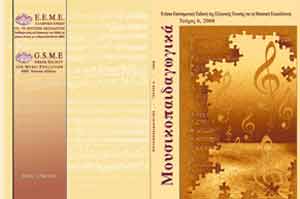
1) Lelouda Stamou: Greek music teachers' self-assessed research interest and knowledge in action research: Comparing the effects of two professional development courses in quantitative and qualitative research
2) Zoe Dionyssiou: Music educational programs and museums: an example from the Museum of Dionysios Solomos in Corfu
3) Theano Koutsoupidou: Musical collaboration and creativity in primary music education: Research and teaching practice
4) Maria Magaliou: Kinetic and iconic representations of music and their role in children's musical development and socio-emotional development: an experimental research in pre-school education
5) Despina Bouldi: Musical experience and emotional responses: A review of the research bibliography
Abstracts:
1) Lelouda Stamou
Greek music teachers' self-assessed research interest and knowledge in action research: Comparing the effects of two professional development courses in quantitative and qualitative research
The study aimed at (a) investigating the effect of a professional development program in action research for music teachers on their self-assessed research knowledge, ability, and interest towards qualitative, and more specifically, action research, and (b) comparing the effects of this program with the effects of a previous professional development program in quantitative research for music teachers. (Stamou, Humphreys, & Schmidt, 2006). Participants were 28 music teachers teaching in public schools and conservatories in different areas of Greece, who chose to participate in a 25-hour professional development course in action research. The Research Interest and Ability Scale (RIAS) (Stamou, Humphreys, & Schmidt, 2006), adopted for qualitative research, was administered at the beginning and at the end of the course to all participants. Reliability for the improved (10-item) RIAS was .35 for the pre-testing and .71 for the post-testing. Low reliability for the pre-testing indicated that the RIAS was not able to function before the seminars, due to the music teachers' lack of familiarity with the concepts of qualitative and action research. The satisfactory reliability co-efficient for the post-testing and the fact that previous research course attendance, holding a university degree, and years of teaching experience did not have an effect on the post-test scores, support the fact that the professional development course was the main influence on them. Findings of this study when compared with findings of a previous study on the effect of a professional development program in quantitative research for music teachers, are indicative of the Greek music teachers' general familiarity with quantitative, but not with qualitative, research.
2) Zoe Dionyssiou
Music educational programs and museums: an example from the Museum of Dionysios Solomos in Corfu
The present article explores the possibilities of designing music educational programs in museums. It examines a possible dialogue among arts that could take place in various museums and at the same time is gives emphasis on aesthetic experience. Aesthetic experience remains one of the basic aims of music education, as well as arts education in general. A music-museum educational program is given as an example of the theoretical thought that is unfolded here. The program under the title: " 'I recognize you from the side': a musical journey through the life and work of Dionysios Solomos", addressed to students of primary schools, was carried out at the Dionysios Solomos Museum in Corfu between spring 2007 and spring 2008. The educational program was designed on the occasion of the 150 years from the death of our national poet. It was based on the triptych music - logos - image, aiming at the development of aesthetic experience in the museum. Here we present the philosophy behind the designing of the program, and how it responds to the theoretical considerations.
3) Theano Koutsoupidou
Musical collaboration and creativity in primary music education: Research and teaching practice
Creativity in music can be practised both individually and collaboratively. Working in groups towards a common goal through discussions about possible solutions and combination of different individual music skills and ideas offers the potential of creating music of a more advanced level, which may demonstrate a wider variety of music qualities. The present article investigates the musical collaborations of children focusing on the four main factors that are involved in musical creativity: the creative person, the creative environment, the creative process, and the creative product. Issues that will be discussed concern children's motivation (creative person), the interactions within a group (creative process), the musical or pedagogical context in which creativity is developed (creative environment), and the final product of children's collaboration (creative product). The discussion is developed based on the observation of vignettes of six to seven-year-old children making music in groups, whilst the benefits of musical collaboration both for children's development and for their creative products in music are discussed based on views and experiences expressed by primary teachers and music specialists. In this way, an effort is made to bring together research (through the observation and analysis of children's creative collaborations in music) and teaching practice (through the analysis of music educators' views and experiences).
4) Maria Magaliou
Kinetic and iconic representations of music and their role in children's musical development and socio-emotional development: an experimental research in pre-school education.
The aim of the study presented in this article was to research the contribution of music activities both to the musical development and the socio-emotional development of pre-school age children, through kinetic and iconic representations. More specifically, through this research we wanted to study the contribution of music activities related to kinesthetic and iconic representations of music to the musical development and the socio-emotional development of 4-6 years old children, who attended kindergarten. The experimental program has been implemented for four months and the examination of its influence on children's musical development and socio-emotional development has been based both on quantitative and qualitative methods of research. The findings of the research showed the positive influence of such a program on the development of children's musical perception and musical skills as well as on their socio-emotional development.
5) Despina Bouldi
Musical experience and emotional responses: A review of the research bibliography
One of the reasons that connect human beings with music is their emotional responses to it. From time to time many theories tried to explore these responses (Expression Theory, Arousal Theory, Theory of imagined persona, Cognitive Theory, Theory of information, etc.). Also, the result of a multidisciplinary approach of the problem was a wide variety of researches, with various theoretic backgrounds and different methodolodies, techniques, questions and means. This inhomogeneousness created a confusion, which is obvious when someone studies the relative bibliography. The present article's intention is a review of the researches that explore emotional responses to music and their categorization based on the variables that examine and their methodology. Finally, a brief critical review with particular proposals for future research is also reported.
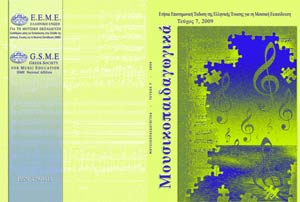
Editorial
1) Athina Kteniadaki: Music in Greek General Secondary Education: Music teachers' attitudes and opinions (p.p. 5 - 33)
2) Marina Sotiropoulou-Zorbala: Pedagogical and aesthetic criteria for the selection and processing of songs in kindergarten and elementary education: Songs for the 'colors' (p.p. 34 - 52)
3) May Kokkidou & Xanthoula Papapanagiotou: Critical thinking and music education (p.p. 53 - 72)
4) Helen Tsakiridou & May Kokkidou: Investigation into the relationship between music education and the development of self-perception and self-esteem in childhood (p.p. 73 - 93)
5) Dimitra Koniari: The perceptual organization of the piece XXXVII from the ''4 Greek miniatures for piano''by Yannis Constantinidis, by adult listeners with or without explicit musical training (94 - 107)
Abstracts:
1) Athina Kteniadaki
Music in Greek General Secondary Education: Music teachers' attitudes and opinions
The present study aimed at investigating General Secondary Music Teachers' opinions, professional profile, instructive approaches and the conditions that they encounter in school contexts. The innovational aspect of this study relies on the fact that there hasn't been any other similar study, of such content and range, concerning music instruction in Greek Secondary Education. The final sample of this empirical study constituted of 163 music teachers, who worked in 26 different geographical regions of Greece, and who anonymously completed a questionnaire that had been sent to them. The present study took place during spring time in the year 2007 in partial fulfilment of the requirements for the Master in School Pedagogy, from the Department of Philosophy and Pedagogy, Aristotle University of Thessaloniki.
2) Marina Sotiropoulou-Zorbala
Pedagogical and aesthetic criteria for the selection and processing of songs in kindergarten and elementary education: Songs for the 'colors'
Under what criteria does teachers, general or art specialist, select the stimuli on which to base an Aesthetic -specifically, a musical- education? Which songs do they choose to teach? Also, how do they process their musical choices? This paper attempts to describe the criteria of a possible approach that primary-school teachers could adopt for the pedagogical evaluation of songs. Starting from the premise that the strictly musicological criteria are necessary but not sufficient, the need is stressed to complement them with educational and aesthetic ones which seem to be overlooked as a rule. Examples are given to analyze ways of selecting and managing songs in the classroom. The paper starts with giving reasons and ways for general or music specialist educators, to treat songs as a field for children to assimilate the subjects they are taught. It then provides arguments and models for activities which lead the teacher to resort to the various axes of aesthetic theory in search of selection filters and ways of processing the songs which he or she allow through the sacred threshold of the classroom. The ultimate aim is to highlight a fact which seems self-evident yet is invariably betrayed in everyday school practice: the potentially crucial role of aesthetic research and theory in the implementation of an aesthetic education.
3) May Kokkidou & Xanthoula Papapanagiotou
Critical thinking and music education
In recent years, researchers in the fields of Pedagogy and Education have stressed out the importance of critical thinking in the development of higher mental functions and in the formation of learning strategies. As a result, latest curricula focus on activities that are considered to contribute to the development of critical thinking. Critical thinking is considered to have an important role in the field of artistic/aesthetic education in general and in the field of music education in particular. Critical thinking skills are directly related to creativity and to tendency for exploration which, in turn, characterize all artistic activities. Additionally, critical thinking skills, as they are pursued in the field of music education, form a cross-curricular frame for the acquisition of new knowledge. In this paper we discuss the terminology related to critical thinking and we focus on the role of critical thinking in the teaching-learning process, especially in the context of music teaching and learning. Finally, we present strategies that might be followed and applied in music teaching and learning which may contribute to the development of students critical thinking.
4) Helen Tsakiridou & May Kokkidou
Investigation into the relationship between music education and the development of self-perception and self-esteem in childhood
Music is an activity in which humans are involved actively-consciously as well as sub-consciously, emotionally and mentally; it is a special way of understanding ourselves and our environment, interacting socially and acting creatively. Many researchers have deduced that people involved consciously and systematically in music do so because it makes them feel emotional fulfillment and elevates their self-esteem. The present research attempts to explore the relationship between music education and the development of self-perception and self-esteem in primary school students. The research was conducted on 1113 5th and 6th grade students differentiated in sex (boys-girls) and music education status (studying music or not). The Harper (1985) questionnaire was used - adjusted for Greek students - which includes six evaluation scales, five related to self-perception and one to self-esteem. The data analysis revealed that the areas of self-perception affected by the music education variable are school ability, conduct/behavior and overall self-esteem. Non-studying-music children tended to have better self-esteem regarding their athletic ability in relation to music educated ones. No significant statistical deviation was noticed between students of the 5th or 6th grade.
5) Dimitra Koniari
The perceptual organization of the piece XXXVII from the "4 Greek miniatures for piano'' by Yannis Constantinidis, by adult listeners with or without explicit musical training
The experimental procedure of segmentation of the musical discourse is used in order to be investigated the influence of explicit musical training in the perceptual grouping of a music piece. The results show that musicians (listeners with explicit musical training) are more consistent in their segmentation process than non-musicians (listeners without explicit musical training), and seem to process music information using cues related to the hierarchies established by the tonal system. On the other hand, non-musicians seem to segment the musical discourse relying more on cues related to acoustic characteristics of the musical surface, such as discontinuities and differences in pitch, loudness and duration. However, mere exposure to music and implicit musical learning can also influence the segmentation performance of non-musicians, leading them to respond to music as musically trained listeners do.
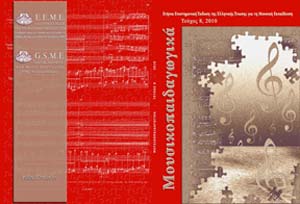
|
Editorial
|
3 |
|
May Kokkidou: Aesthetic Education and Aesthetic Literacy: historic overview and current issues
|
5 |
|
Εirini Nikolaou: Music education in Plato’s Republic
|
26 |
|
Elissavet Perakaki: Teaching Thinking Skills and Music Education
|
42 |
|
Maria Emma Meligopoulou: The school choir in three types of Greek middle schools: public, private and music schools: An empirical research with comparable elements regarding structure, applied methodology, function and other practical issues
|
62 |
|
Konstantinos Dinopoulos: The teaching of music, and particularly Greek traditional music, with the use of new technologies: an experimental research project in elementary education |
94 |
Abstracts:
Aesthetic Education and Aesthetic Literacy:
historic overview and current issues
May Kokkidou
The term «Aesthetic Education» has been used and interpreted in various contexts. It implies, frequently, a type of education in the rules of arts emphasizing in the development of a particular way of students' thinking. In a wider perspective, it is not necessarily considered interwoven with the arts but as a distinct dimension of learning and experience. A third approach raises from the perception of aesthetic as a philosophy of art. Within this approach, aesthetic education includes the study of issues such as techniques, concepts, critic evaluations, values, and expectations regarding artistic creation and the appreciation of works of art.
Several theorists and philosophers (e.g., Schiller, Read, and Dewey) highlighted the importance of Aesthetic and Art Education and stated that Aesthetic Education should be an integral part of every educational system.
In the present paper we discuss the axes of Aesthetic Experience and Aesthetic Literacy while we attempt to illuminate the dimensions of Aesthetic Education, diachronically and synchronically, through the references to movements that dominated the field and through the presentation of controversies of important theoreticians and researchers of the field.
Music education in Plato’s Republic
Εirini Nikolaou
Plato, in his masterpiece Republic, examines the status of music in education and its power in influencing ethos of a human being. Music in Plato, and generally in antiquity, had a broadened sense than it has today, meaning education of all “means” and it included poetry, theatre, art and so on. The sectors of music education in Republic, are: 1. Myths and their right choosing 2. The right way in expressing those myths. 3. The suitable melodies and harmonies, the right rhythms and instruments in educating of youngsters. Through musical education, Plato sees the route to virtues, like wisdom, bravery, temperance, generosity. One can get this kind of education through addiction and exercise and is addressed to the moral and intellectual culture of citizens. Plato’s aspects about music education have influenced the thought of posterior philosophers and educators and render his work current concerning the music education of today.
Teaching Thinking Skills and Music Education
Elissavet Perakaki
During the last decades in the Syllabus and within the educational field in general, the importance of developing critical thinking skills as a means of learning is greatly emphasized. This is in contrast to the knowledge-oriented way of learning implemented until today. The development of criticalthinking skills should be systematic in order to be effective. E. Matsagouras’s Programme on teaching pupils about Critical Thinking emphasizes on the development of critical thinking skills based on Vygotsky’s and Piaget’s theories of learning and development. This Programme has already been implemented in Primary and Secondary Education in Greece and has also been the basis for this particular music lesson research. In this case study research participated 50 pupils from two High Schools in rural areas in Greece, aged 12. The aim of the research was to explore whether acritical thinking development programme could be adapted within a music lesson and develop pupils’ critical thinking skills on music. The results can be summarized that the Critical Teaching Programme can be adapted within music lessons, increasing pupil’s interest on music and enhancing their participatory skills.
The school choir in three types of Greek middle schools: public, private and music schools: An empirical research with comparable elements regarding structure, applied methodology, function and other practical issues
Maria Emma Meligopoulou
The present article is a primary national research among three types of Greek School choirs, - public, private and music middle schools-, which constitute the great majority of Greek type of schools. The research aims to discover the functioning ways of the Greek school choir, the applied teaching strategies, the chosen repertoire, the choirs’ size, the kind of polyphony, the sex’s analogy, the choristers’ age, the schools’ substructure, as well as the level of the scientific accuracy of the teachers in choral education and their own valuation regarding the choral education programs they attended at the Greek universities as students. The results of the research showed that the Greek middle school choir is currently going through a consistent progress and musical grow surrounded by problems that are mainly related with the teachers’ deficiency on teaching the choir, the absence of scientific applied teaching methods, the absence of infrastructure appropriate for the school rehearsal room, the absence of syllabus and handbooks both for the teacher and the student as well as problems that are related with the hour and the length of the choral teaching time.
The teaching of music, and particularly Greek traditional music, with the use of new technologies: an experimental research project in elementary education
Konstantinos Dinopoulos
One of the basic goals of the study was to highlight the usefulness of new informatics and communications technologies in the music education process. To show the benefits that result from this process of teaching-learning with the use of new technologies. To provide a motive to youngmusic educators in Greece, mostly in elementary education, to include new technologies in their daily course load, by providing them with all the information that would render this educational process possible. Starting with the organization of the school informatics lab, the teachers’ role in a technologically enhanced learning environment, and the way in which they can manage the course material through independent and networked multimedia environments. The creation of a “training framework-program for future music educators during their studies at universities, relevant to the teaching of music with the use of new technologies”, which is elaborated to some extent in the proposals of the doctorate dissertation, occurred as a result of all the above.
The implementation of the study required, among other things:
-
Technical equipment (computing and networking hardware) in compliance with determined specifications, which had to be present at the school unit that participated in the study. The existing equipment was enriched with additional material (keyboard music, laptop computer,etc.), thus providing greater capabilities for flexibility, musical expression and creativity.
-
Music educational software (DVD-ROM) relevant to the subject “Greek Traditional Music” (topics: elements and types of Greek traditional music, Byzantine music, etc.), as well as digital musical content available through the Internet (topics: elements of music theory, voice–solfege exercises, midi, etc.; hosted by the educational portal of the Greek Ministry of Education and Religious Affairs, on the website:http://www2.e-yliko.gr/htmls/epimorf/music/default.html).
-
Multimedia environments combining text, music notation, digital sound and images, graphics, video, and midi, enhancing the relationship between the audio and visual representation of music; i.e. seeing, for example, a music interval, a melody, a rhythm, while listening to it at the same time. Necessarily created by the researcher, due to a lack of similar digital material.
Consequently, through the “music system” and particularly through the material and software that was coordinated and produced, the students –through educational activities (seminars – lessons) that were created, and the guidance of the researcher through a new educational role in atechnologically enhanced learning environment – had the opportunity, among other things, to learn-discover music, to experiment and explore, toexpress themselves and to create music in relation to the means of musical expression (body, voice, musical instruments), etc.
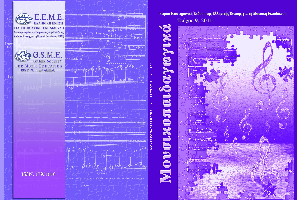
|
Editorial
|
3 |
|
Patrick Freer – Antonis Ververis: Male adolescent changing voice and choral music education in the United States of America
|
5 |
|
Konstantinos Tsahouridis: Pontic Singing in Contemporary Greece: Vocal Techniques and Pedagogical Implications of an Aural/Oral Tradition
|
24 |
|
Dimitra Koniari: Critical and sensitive periods for music learning
|
51 |
|
Nikos Theodoridis: Views and opinions of kindergarten teachers about music teaching and their music-pedagogical education
|
62 |
|
Marianna Rontogianni: Music Technology and Music Education: Historical Development and Current Issues
|
79 |
Abstracts:
Male adolescent changing voice and
choral music education in the United States of America
Patrick Freer – Antonis Ververis
Despite the interest that researchers have shown worldwide in the study of male adolescent changing voice during the past seventy years, the Greekeducational system seems to ignore this issue. Two researchers -one from the United States and one from Greece- both in the field of Choral Education collaborated for this article, the purposes of which were the following: (a) to present an overview of research concerning the male adolescent changing voice, (b) to present teaching methods suggested by American educators and students, and (c) to make suggestions for practice within Greek music education classrooms and the training of music educators in Greece.
Pontic Singing in Contemporary Greece: Vocal Techniques
and Pedagogical Implications of an Aural/Oral Tradition
Konstantinos Tsahouridis
This article examines the vocal techniques employed by performers of contemporary Greek Pontic traditional music. Combining fieldwork analysis with personal experience, the author offers an evidence-based explanation of the underlying cognitive and physiological processes that inform these techniques. While anatomical considerations constitute a central focus of this analysis, an appraisal of pedagogical implications suggests points for consideration that apply to aural/oral folk traditions, such as Pontic. The objectives of this research were: (a) to identify the current vocal techniques of singing in a Pontic style, (b) to bridge the gap between theory and practice in studies of voice and vocal production, (c) to present specific pedagogical approaches, and d) to display the discipline of auto-ethnography as a research tool in the field.
Critical and sensitive periods for music learning
Dimitra Koniari
While most of music pedagogy methods stress the importance of early musical experience and training for achieving high levels of musical expression and for the social, cognitive and sentimental development of children, there is actually little neurobiological evidence on this question. The article reviews studies on brain development and the notions of “critical” and “sensitive” periods for achieving musical expertise. It appears that sensitive periods for music training are probably quite fluid and that the adult brain retains some plasticity to acquire musical expertise also later in life.
Views and opinions of kindergarten teachers about music teaching and their music-pedagogical education
Nikos Theodoridis
The article focuses on kindergarten teachers’ preferences for teaching music in relation to other objects of artistic education. Results show that kindergarten teachers in Greece recognize the importance of music teaching in the form of a long term planning of the musical curriculum. However, they complain about the lack of musical knowledge and competence from their basic studies and the need for an in-service educational programme on music education in kindergarten.
Music Technology and Music Education:
Historical Development and Current Issues
Marianna Rontogianni
We live in times of rapid technological development which affects considerably all aspects of human life. Composing, editing and performing of music have changed dramatically with immediate effects on music teaching and learning. People have never stopped trying to invent new ways of musical expression and the efforts of numerous scientists have resulted in the various music tools that all professional musicians, music teachers and students possess today. The use of technology in schools is integrated part of the National Curricula of all developed countries today and is grounded upon concrete theoretical base. Research results considering the use of technology in education and in music education in particular are presented, as well as the place of music technology in the Greek educational system. The role of the teacher of music for an effective use of technological tools in music classroom is stressed.
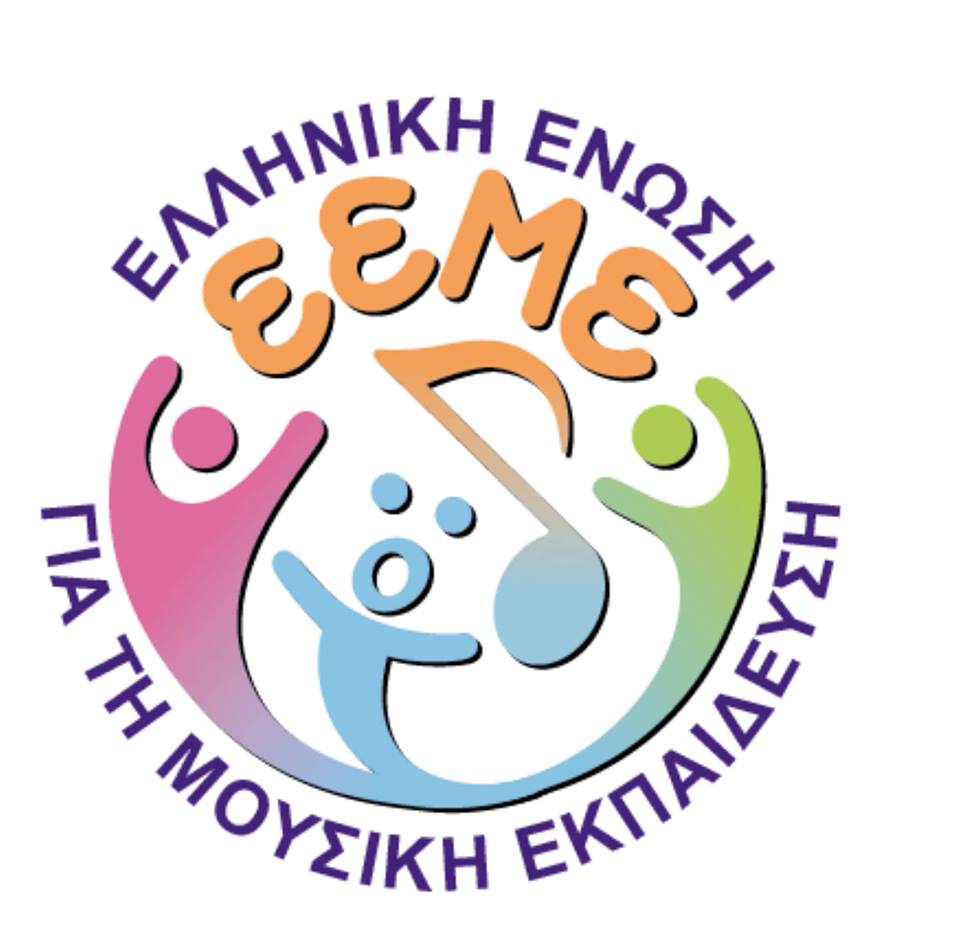



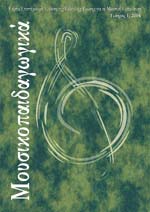
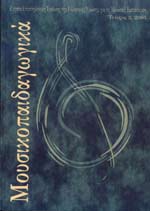
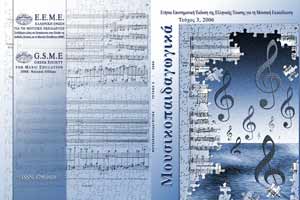
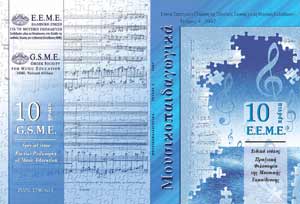
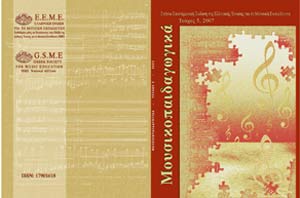

 Please wait...
Please wait...